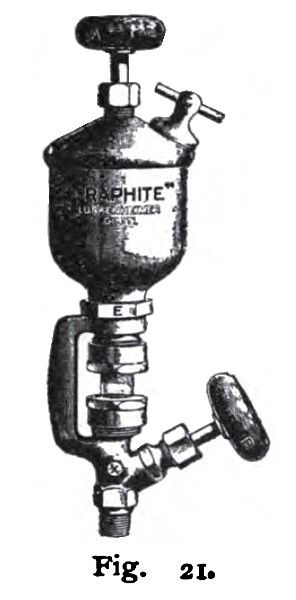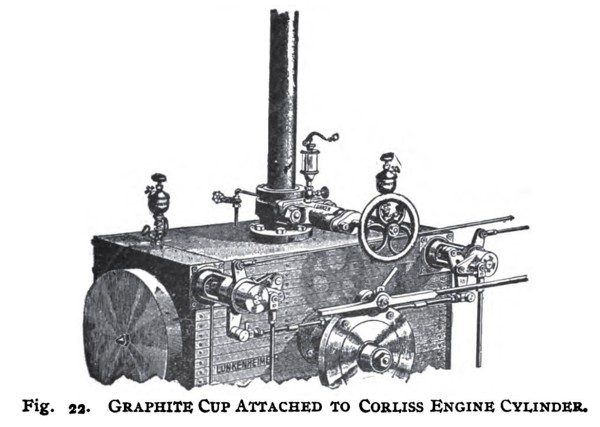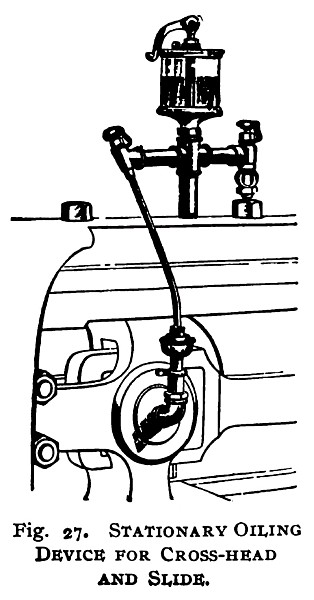In "keying up" an engine, the engineer should know where his keys are before attempting to adjust them—to know this, the keys should be marked before they are moved; this is best done with a lead pencil, for if it is found that the key has been driven too far it can be easily put back to its former position and when the machine is running in a satisfactory way, the marks can easily be removed.
It is also better to key up an engine in the morning rather than at night; if it is done at night, the engineer does not know "what a night may bring forth" nor that he will be in his place in the morning.
For all joints that have to be broken and remade frequently the ground joint is the best.
By its use one does not have to bring everything to a standstill while a gasket is being hunted up or being cut, all the while the delay costing money. The occasions for doing this should be as few as possible.
In putting rubber packed joints together use either graphite or chalk to prevent the rubber adhering to the iron when the joint has to be remade.
In packing a stuffing box it is of the first importance that the piston rod should be in line and be smooth ; if the rod is scored, or rusty, it should be smoothened with emery cloth, otherwise it will act upon the packing in the same manner as a file.
Measure the packing around the rod, and cut it to exact lengths. A very good device for cutting packing, is a piece of hard wood, turned to the exact diameter of the rod.
Note.—Many engineers measure the packing rings to length and then cut it, but this is not the best way, for the ends, after the packing is bent around the rod, will not come together flush. It is good practice to put a little graphite in the stuffing box, when packing, as this will lengthen the life of the packing and decrease the friction.
By winding a ring of packing around this, it can be cut off to fit the rod to perfection; always break joints by putting them opposite each other, in adjoining rings; never set up too tight, for if a stuffing box is perfectly packed, it will hold tight with but little tension on the gland, and if packing is jammed too tight, much power is lost in friction.
If the speed of the engine is changed, care should be taken to adjust the springs so that the sound, when they are tapped with a hammer is as near alike as possible. Different sounds indicate an unequal tension, and the result of unequal strain may be " racing" of the engine.
Care should be taken that the dash pot is always full of machine oil, or oil of a heavier grade, or else glycerine, as the dash pot is designed to give stability to the governor when load is changed, and its movement must not be too quick. The dash pot will be next to useless if the filling part is neglected.
When the piston rings do not properly fit the cylinder bore or are faulty in the joints loss is caused by allowing steam to blow from the admission end past the piston into the opposite end, which is open for the exhaust.
A good way to ascertain if the piston is leaky is to put the engine on the dead center on the crank end. Then take off the cylinder cover on the head end and admit steam back of the piston. If it leaks the leak can readily be seen.
Note.—
Many engines are so constructed that the space around the piston rod gland is quite small, and so we would suggest that a short solid wrench be made for use in such cases, and always be kept in a convenient place. As it is seldom or never necessary to use much leverage here, a large one will not be needed and it will be much more convenient than to try to use an ordinary monkey wrench. Another method is to place the engine on the center— no matter which one—and if the cylinder is piped for indicator, open cock from opposite end from which steam is admitted. While this method would give good results if the valve was tight, it would not give the desired result if the valve was leaky.
Packing rings that are found to be too small for the cylinder bore should be set out either by tightening the setting out bolts or by peneing, the best method obviously being determined by the circumstances. To spread a ring by peneing its inside circumference should receive a succession of blows from the ball, or pene, of the hammer, around its entire length, and care should be taken that the blows should be struck as nearly as possible in the center of the ring and at equal distances apart, otherwise the ring is apt to assume more or less of a spiral form.
To secure smooth running in an engine the packing rings should clear the bore of the cylinder a little at each end of the travel. Many engines are designed so that the rings travel over the bore about 1-32 inch.
Graphite has proven to be a very good lubricant for engine cylinders and valves, and if a cylinder or valve is badly scored, it will lodge in the pits and scratches of the rough surface, and restore it to its original smoothness, saving steam.
 Graphite Lubricator Cup |
The graphite may be fed into the cylinder by means of an ordinary tallow cup, but it is best to use a specially made cup for this lubricant, as shown in Fig. 21. This device, as well as several oilers and lubricators illustrated in this book, is manufactured by the Lunkenheimer Brass Co., Cincinnati, O.
As the cup is made for the purpose of feeding graphite into the cylinder, there is no chance for it to lodge in a recess and clog up the feed. It also is a sight-feed lubricator, as will be noticed in the cut.
Note.—
It is well to make periodical inspection of cylinder to ascertain whether the piston has lost its proper alignment by wear or other cause, if the cylinder has been cut, if the follower bolts are secure and free from fracture, if shoulders have been formed at ends of bore from improper lining of connecting rod, whether cylinder oil is causing deterioration by acid which it may contain, etc.  Graphite Lubricator Cup Attached to Corliss Engine Cylinder |
Fig. 22 shows a way of attaching these cups to Corliss engines. They may also be attached to the steam pipe, but always below the throttle valve, as the graphite may interfere with the tight closing of the valve.
When using graphite, an oil lubricator should also be used, but the quantity of oil can be reduced considerably.
When taking measurements to set piston in center of cylinder don't take them from the bore, but always from the counterbore. The reason for this is that while the bore may be badly worn, either vertically or horizontally, the counterbore receives no wear and retains the original alignment.
When an engine has been erected or overhauled for repairs, and before the pistons are put into the cylinders, it should be "blown through." The throttle valve being opened, the steam allowed to blow through steam chest and ports into the cylinder, the valve gear being moved by hand so that the steam will blow through the parts alternately. If by accident, nuts, washers, iron dust or other substances should remain in the passages they will then be dislodged and a serious menace to safety removed.
 Drop Lubricator |
Note.—
Description of Fig. 23.
B—Oil reservoir. C—Upper valve. E—Filling plug. F—Drain, valve. H—Union to connect condenser pipe and valve. K—Discharge valve. L—Valve for regulating flow of oil. N—Indicator glass. P— Sight-feed glass. Valve to drain or blow out sight-feed glass P.  Spray Lubricator |
Note.—
Description of Fig. 24. A—Condensing chamber. B—Oil reservoir. C—Filling plug. D— Upper steam valve. F—Drain valve. K—Lower steam valve. L— Valve fo regulating flow of oil N—Indicator glass. P—Sight-feed glass. R—Steam pipe. SS—Plugs for cleansing and replacing glass. T— Circulating tube. X—Spray nozzle. The "striking points" should be located, also the "counterbores." The following is a simple, yet effective method of finding these points. After the piston rod has been keyed in the crosshead, move it towards the crank end until the "spider" brings up solidly against the cylinder head. This is the striking point for this end. It should be located on the guide by a center punch mark at the crank end of crosshead. Move the crosshead toward the head end of cylinder until the turned edge of spider against which the ring will bear comes flush with the counterbore. Mark this point also on the guide at same end as before. Next move crosshead along and put in packing ring and riding ring. After these are in position move piston ahead until the ring on head end is flush with the counterbore. Locate this point also on the guide.
 Double Sight Lubricator for Compound Engines |
 Automatic Lubricator |
Put cylinder cover on head and move piston ahead until it strikes. This is the striking point for head end—locate on guide same as before. This makes the job complete and when the connecting rod is put up it can be lined by these marks on guides.
The piston should be moved through cylinder a few times to see if everything works freely.
Follower bolts lose much of their original strength by reason of crystallization caused by alternate cooling and heating. A comparatively small strain will sometimes fracture a bolt that has been in use some years. Many engineers make a practice of renewing these bolts at certain intervals of time, and the practice is highly commendable. When the follower has been taken off for some reason and when the bolts are replaced, it is the best method to bring them up to a bearing before putting a strain on them with a wrench.
 Stationary Oiling Device for Cross-Head and Slide |
Every engine should be fitted with stationary oilers for crank-pin, wrist-pin and all other places where the bearing is a movable one. This will enable the engine to be run for many consecutive hours, if occasion should demand it. To be obliged to shut down to oil any of these places, is to show that whoever is in charge of the machine has failed to keep up with the times. See Fig. 27.
In selecting a lubricator for a steam engine it is well to get one that is so constructed that when it must be filled, the cylinder oil will go directly into the cup, without having to go through a long crooked passage, for many good oils are thick and it is not always convenient to warm an oil before using it.
Information Sources
- New catechism of the steam engine 1902 pages 50-56